the Creative Commons Attribution 4.0 License.
the Creative Commons Attribution 4.0 License.
Technical note: The recovery rate of free particulate organic matter from soil samples is strongly affected by the method of density fractionation
Frederick Büks
Ultrasonication combined with density fractionation (USD) is a method widely used to separate soil organic matter pools. A selective fractionation of free particulate organic matter (fPOM) is crucial to avoid co-extraction of retained fPOM along with occluded particulate organic matter (oPOM). In the present work, artificial fPOM was extracted from two mineral matrices, sandy and loamy, after applying different approaches for merging a sample and dense medium. It is shown that pouring the dense solution to the mineral matrices without mixing leads to low recovery, whereas trickling the sample into the solution, rotating after fill-up or applying a minimal and defined amount of ultrasound to swirl up the sample causes nearly full recovery of the artificial fPOM. Applied to natural soils, our results confirmed the low extraction rate of the unmixed approach. It was also further shown that the rotational approach results in only a slightly increased extraction rate, whereas the ultrasound approach leads to a release of oPOM into the fPOM fraction due to disruption of soil macro-aggregates. The trickle approach appears to be the most appropriate way from the tested methods to achieve complete and selective extraction of fPOM from natural soil samples.
- Article
(5955 KB) - Full-text XML
-
Supplement
(395 KB) - BibTeX
- EndNote
In soils, particulate organic matter (POM) occurs free (fPOM) and occluded within soil aggregates (oPOM) (Golchin et al., 1994). Both organic matter pools with different chemical composition, structure and decomposition rates are the subject of widespread experimental issues into carbon pool balances, soil structural stability or turnover times (von Lützow et al., 2007; Wagai et al., 2009; Büks and Kaupenjohann, 2016; Graf-Rosenfellner et al., 2016). A widely used method to separate fPOM and oPOM is ultrasonication combined with density fractionation (USD) (Kaiser and Berhe, 2014). Both POM fractions are thereby determined indirectly by quantification of the operational non-aggregated particulate-free light fraction (fLF) and the occluded light fraction within soil aggregates (oLF) (Golchin et al., 1994; Büks and Kaupenjohann, 2016). The congruence between light fractions and actual POM pools is reduced by low recovery rates and the carryover between the pools, as recently shown for oPOM and mineral-associated organic matter (MOM) (Büks et al., 2021). A sharp separation without cross-contamination between the measured pools is therefore necessary.
This work focuses on the separation of fPOM and oPOM, driven by two observations: (1) a pre-experiment following the specifications given below for the extraction of POM from soil samples showed a separation of 28.7 ± 3.1 mg fPOM when the density fractionation solution was added to the soil sample without mixing but 44.8 ± 7.4 mg when the sample was gently trickled into the dense solution (± standard deviation; n=3; t test; p<0.05). (2) The treatments of mixing soil sample and dense solution prior to the extraction of fPOM apply a wide range of mechanical stress ranging from non-mixing (Büks and Kaupenjohann, 2016) to swaying (Graf-Rosenfellner et al., 2016), gentle inversion (Golchin et al., 1994), swirling (Cerli et al., 2012), shaking (Schrumpf et al., 2014) and ultrasonic pre-treatment (Don et al., 2009). Due to the very different performances of the above approaches and the diversity of commonly applied treatments, the aim of this work is to compare methods with different underlying principles of mixing in order to identify those with most accurate separation of fPOM and oPOM.
2.1 The simple scenario: extraction of low-density polyethylene (LD-PE) particles from mineral matrices
In a first experiment (Fig. 1), two simple model soils were prepared from a mineral matrix of calcinated fine sand (89.7 % sand, 9.3 % silt, 1.0 % clay) and a calcinated clayey silt (8.7 % sand, 69.7 % silt, 21.6 % clay), each amended with 1 wt % of weathered low-density polyethylene made from cryo-milled film (LD-PE; weathered for 96 h at 1000 W m−2, and 38 ∘C and 50 % relative humidity following the German Institute for Standardization, European Standard and International Standardization Organization (DIN EN ISO) 4892-2/3: x10 %=246 µm, x50 %=435 µm, x90 %=691 µm, ρ=0.92 g cm−3) as a well-defined fPOM representative. The LD-PE is considered a feasible analog of natural POM, as it provides a similar range of density and particle size and widely non-reactive surfaces, which reduces surface interactions with the mineral phase. This setting allowed for focusing on artifacts caused by mechanical reasons such as sedimentation behavior and impeded flotation. The textures of the two mineral matrices represent different sedimentation rates, likely affecting the recovery rate of the LD-PE.
Four treatments with six replicates each of 20 g soil sample and 100 mL 1.6 g cm−3 dense sodium polytungstate solution (SPT) in 200 mL centrifuge bottles were tested: one in which the soil samples were gently filled up with solution but stayed further unmixed, one in which the soil samples were trickled into the solution, one in which the flasks were gently tilted by 90∘ and axially rotated three times with 20 rpm to unhitch the sedimented soil matrix from the bottom of the flask, and one that was agitated by ultrasonication (Branson© Sonifier 250; sonotrode diameter of 13 mm, frequency of 40 kHz, immersion depth of 15 mm, power output of 52.06 ± 1.67 J s−1) until the sediment was completely swirled up (pre-sonicated). The respective time of sonication (tmin) was determined to be 7.0 ± 1.3 s for the sandy and 34.0 ± 1.9 s for the loamy soil (see Supplement). The corresponding energy densities wmin were calculated following North (1976) and amounted to 3.0 ± 0.5 and 14.7 ± 0.8 J mL−1, respectively.
In order to extract the POM, samples were centrifuged at 3500 G for 26 min. The floating LD-PE was collected by use of a water-jet vacuum pump and cleaned with deionized water to remove remaining SPT salt by use of a 0.45 µm cellulose acetate membrane filter until the electrical conductivity of the filtrate fell below 50 µS cm−1. The extracted LD-PE was then flushed off the filter with deionized water into aluminum bottles, frozen at −20 ∘C, lyophilized (freeze-dried) and finally weighed to determine the recovery rate.
2.2 The complex scenario: extraction of POM from natural soils
In a second experiment (Fig. 1), two topsoil samples, sandy (89.7 % sand, 9.3 % silt, 1.0 % clay) and loamy (25.5 % sand, 55.9 % silt, 18.7 % clay), were air-dried and sieved to receive aggregates of 250 to 2000 µm in diameter. In six-fold replication, 20 g of soil aggregates were gently adjusted via spray to a water content of 200 mg g−1 dry soil, low enough to avoid aggregates sticking to each other or to the flask, and incubated for 2 weeks at 20 ∘C in the dark. After the removal of shoots of randomly germinated seeds, soil samples and SPT solution were merged following the four approaches, and the fPOM was extracted in the same manner given above. Subsequently, all samples were refilled to 100 mL of SPT per flask, and were equally treated by application of w=50 J mL−1 with the exception of the pre-sonicated treatment that received w=50 J mL. Afterwards, the oPOM was extracted as above, followed by centrifugation, collection, cleaning, freezing, lyophilization and quantification by weighing. Finally, all POM samples were ground, dried at 105 ∘C and the amount of organic carbon and total nitrogen were determined using an Elementar Vario EL III CNS Analyzer.
2.3 Statistics
Recovery rates from mineral matrices, fPOM, oPOM and ΣPOM release, proportions of total carbon of the fPOM, oPOM and residuum fractions, and corresponding C:N ratios were compared for all soil matrices separately by one-way analysis of variance (ANOVA) and Tukey test.
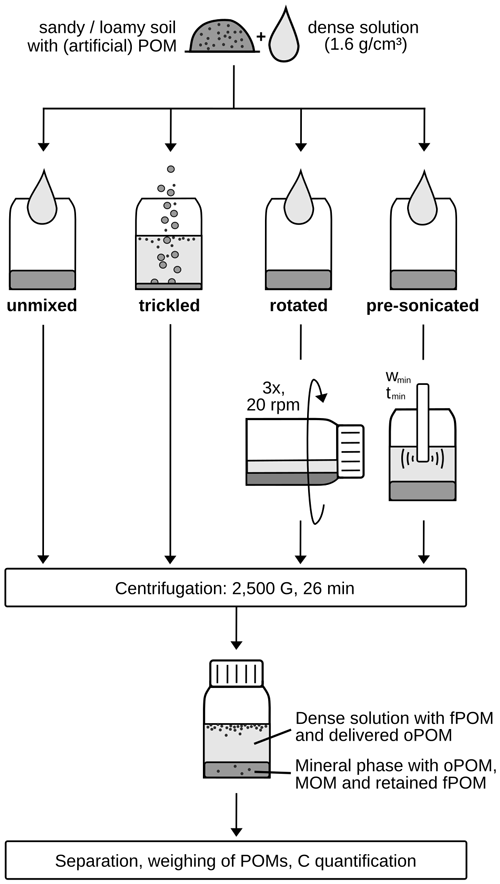
Figure 1Separation of free particulate organic matter (fPOM) from mineral soil matrices and occluded particulate organic matter (oPOM). Four different treatments were used (unmixed, trickled, rotated three times with 20 rpm, and swirled up by pre-sonication using a minimum of mechanical stress wmin and application time tmin) and applied in both the simple and complex scenario.
3.1 Recovery rates from mineral matrices
The results show that the unmixed treatment provided by far the lowest recovery rate in both the sandy and clayey mineral matrix (68.3 ± 9.0 % and 58.9 ± 13.7 % of the applied LD-PE, respectively). In contrast, trickle, rotate and pre-sonicated have similarly high recovery rates ranging from 90.4 ± 5.8 % to 98.2 ± 1.1 % across all samples (Fig. 2).
3.2 Recovery rate and characteristics of POM in natural soil samples
The application of all four approaches to aggregates of the loamy natural soil showed that the unmixed samples released by far the lowest mass of fPOM and percentage of total SOC, followed by the rotated and clearly excelled several times over by the trickled and pre-sonicated treatment (Table 1). Unlike the other fPOMs, the fPOM of the pre-sonicated treatment has significant amounts of dark fine material. This comes along with the lowest C:N ratio, slightly reduced compared to the other fPOMs, and an increased C:N ratio in the residuum. The yield of the pre-sonicated oPOM fraction was strongly reduced compared to the other treatments and showed the release of almost exclusively fine material. This is in contrast to unmixed, trickle and rotate, which had similar appearance with traces of coarse material. In sum, the trickled sample had the largest release of ΣPOM = fPOM + oPOM, followed by the rotated samples.
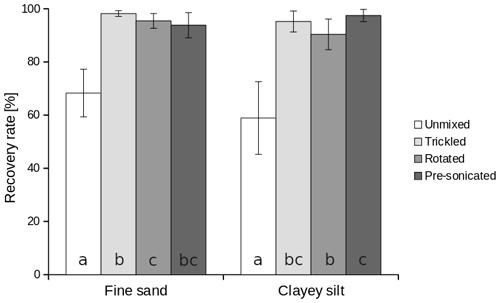
Figure 2Recovery rates of fPOM (weathered LD-PE) from mineral matrices after fractionation with 1.6 g cm−3 dense SPT solution using different approaches (n=6; t test; p<0.05). Small letters indicate Tukey's characters. Error bars refer to standard deviation.
Table 1Soil organic matter (SOM) release of a loamy topsoil after different approaches for merging sample and dense medium. fPOM refers to the free particulate organic matter floating after application of 0 J mL−1, oPOM to the occluded particulate organic matter released after application of 50 J mL−1 (∗ in case of the treatment with minimum ultrasonication of 15 and 35 J mL−1, respectively). Ctot refers to the percentage of total SOC contained in each fraction. ± refers to the standard deviation. Small superscripts are Tukey's characters (a, b, c, d) and mark significant differences between the treatments of the loamy soil (p<0.05).
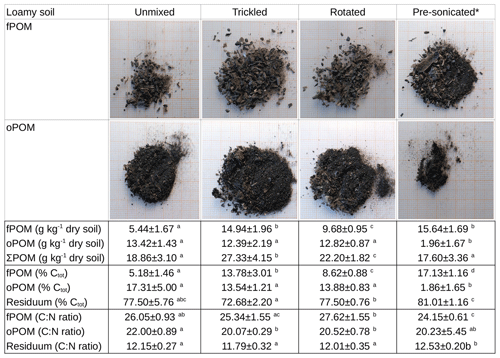
Similar to the loamy soil, the unmixed sandy soil samples showed the smallest amount of extracted fPOM, followed by the rotated ones (Table 2). The pre-sonicated and trickled samples released the highest amount of fPOM which significantly increased by about 93 % compared to the unmixed samples. This pattern appears similarly with SOC. The release of oPOM from pre-sonicated samples was reduced compared to the unmixed, trickled and rotated samples. In sum, the unmixed samples released the smallest and the trickled sample the highest amount of ΣPOM.
In contrast to the rougher treated loamy samples (15 J mL−1), pre-sonication of sandy samples with 3 J mL−1 did not cause any additional release of fine material within the fPOM fraction. There were no significant differences of the C:N ratio between all treatments, and all fPOM fractions showed a very similar appearance. On the other hand, the oPOM fractions of the unmixed samples and, to a lesser extent, the rotated samples showed an increased number of coarse particles compared to the other treatments. These particles appeared to be similar to those found within the fPOM fraction, whereas the pre-sonicated oPOM fraction contained nearly no coarse material. This comes along with the occurrence of the highest oPOM C:N ratio in the unmixed samples and the lowest in the pre-sonicated and trickled samples. Similar to the loamy samples, the residual C:N ratios in all sandy soil treatments are low compared to the fPOM and oPOM fractions, and it showed the highest values in the unmixed and rotated treatments.
Table 2Soil organic matter (SOM) release of a sandy topsoil after different approaches for merging sample and dense medium. fPOM refers to the free particulate organic matter floating after application of 0 J mL−1, oPOM to the occluded particulate organic matter released after application of 50 J mL−1 (∗ in case of the treatment with minimum ultrasonication 3 and 47 J mL−1, respectively). Ctot refers to the percentage of total SOC contained in each fraction. ± refers to the standard deviation. Small superscripts are Tukey's characters (a, b, c, d) and mark significant differences between the treatments of the loamy soil (p<0.05).
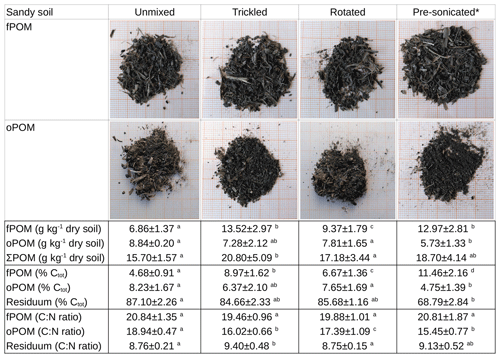
This work was able to show significant differences in the extraction performance of the different approaches. As demonstrated in the first experiment, the recovery rate of LD-PE particles from sandy and loamy mineral matrices is strongly reduced by use of the unmixed method. This implies that filling the dense solution on top the soil sample causes parts of the fPOM to be buried under the mineral matrix. Consequently, it is suggested that the unmixed approach is not an adequate method to avoid incomplete extraction of fPOM. The retained fPOM will be in turn found within the oPOM fraction leading to both underestimation of the fPOM and overestimation of the oPOM fraction. The other approaches, in turn, were shown to have similar extraction performance in terms of non-occluded, weakly interacting LD-PE particles within a solely mineral matrix.
However, physiochemical interaction of surfaces, biofilm formation, particle density of organic and inorganic matter as well as occlusion within soil aggregates could provide additional interference between SOM and the mineral phase during extraction of POM from natural soils (Bronick and Lal, 2005; Kaiser and Berhe, 2014). The second experiment was therefore performed with samples of aggregates from sandy and loamy soils.
Similar to the first experiment, in both the sandy and loamy soil the extracted amount of fPOM was strongly reduced in the unmixed treatment, but also in the rotated treatment, compared to the two others. Since the fPOM of the sandy soil shows a similar C:N ratio and composition of coarse (less degraded) particles across all approaches, the fPOM of all sandy soil treatments can be considered free of (fine, more strongly degraded particulate) oPOM. In turn, the oPOM fractions of the unmixed and rotated treatment contain more coarse material and have a significantly higher C:N ratio compared to the others. This indicates the input of parts of the coarser fPOM fraction, that has a higher C:N ratio. In consequence, the trickling and pre-sonication caused less cross-contamination and are, thus, both considered yielding and sharp methods to extract fPOM from sandy soil samples. Due to its higher total POM yield, trickling is to be preferred over pre-sonication for the quantification of soil carbon pools.
In contrast to the sandy soil, the fPOM of pre-sonicated loamy sample contains significant amounts of fine, more decomposed material and a decreased C:N ratio. This artifact can be explained by the application of mechanical stress through the use of wmin to swirl up the soil sample. The ultrasound led to the disruption of macro-aggregates and the release of a more strongly degraded and less coarse soil organic matter fraction. As shown by Wagai et al. (2009) and Cerli et al. (2012), such fractions can have in some cases a lower C:N ratio. The effect is missing in the sandy soil samples, which were treated with only 3 J mL−1, but appears at 15 J mL−1 with loamy soils. Following Kaiser and Berhe (2014), the applied energy is well below ultrasonic levels that have been reported to disperse soil aggregates, but may still break down very weak macro-aggregates. In contrast, findings of North (1976) and Golchin et al. (1994) point out, that even low dispersive energies <10 J g−1 already lead to a strong release of clay particles from aggregates of a clayey soil.
In addition, the oPOM yield of the pre-sonicated treatment is strongly reduced, coming along with an increased SOC content of the residuum. This effect did not appear with plastic particles in the first experiment and might be related to ultrasonic comminution of natural POM leading to stronger sorption of the fine particle fraction to the mineral matrix as described by Büks et al. (2021). Although pre-sonication provides the highest fPOM yield in loamy soils, this method is not recommended due to the low total POM yield and aggregate disruption and cross-contamination between POM pools. The greatest release of total POM by far is achieved using the trickle approach, which caused no signs of cross-contamination.
Based on the performance of the four approaches (Table 3), the following general recommendations are made regarding their use. The unmixed method is greatly affected by its very low fPOM recovery and fPOM artifacts within the oPOM fraction. Rotating shows characteristics similar to the unmixed approach. It allows a higher but still insufficient POM recovery from natural soil samples, while applying an undefined amount of mechanical stress to aggregates. Together with the trickle approach, pre-sonication shows the highest fPOM yield, it might be effective when applied to sandy soils, but it causes cross-contamination and low oPOM yield with loamy soils. The trickling method, in turn, avoids mechanical agitation, has high recovery of fPOM combined with the highest total POM yield, and hardly shows any visible nor measured cross-contamination. Suitable for a wide range of water contents, it might however be inadequate for the application on very moist or saturated field-fresh or pre-incubated samples that adhere to the sampling container in such a way that it is difficult to transfer without mechanical stress, e.g., by use of a spoon.
Table 3Performance of the four different approaches (unmixed, trickling, rotation and pre-sonication). oPOM recovery is called unknown, if the oPOM fraction is contaminated with fPOM material.
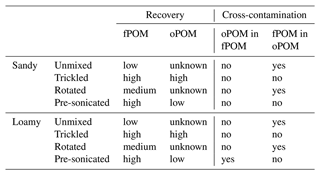
Based on our findings, a modification of the common approaches is recommended, that includes gentle trickling of field-fresh or pre-incubated samples with water contents below field capacity into the density separation solution instead of adding the solution to the sample. This reduces mechanical stress to the sample and avoids burying significant parts of the fPOM under the mineral phase during the extraction of the fLF, which is then co-extracted along with the oPOM in the following step.
The complete and selective extraction of POM fractions with ultrasonication/density fractionation (USD) is an important step of SOM pool quantification and the assessment of their properties. It is shown that the unmixed and rotated approach cause strongly decreased recovery of fPOM and a contamination of the occluded light fractions with fPOM. This causes the misquantification of both fractions and might lead to the underestimation of the labile and an overestimation of the intermediate soil carbon pool. In addition to a number of less suitable alternatives, trickling (the soil sample into the dense solution) is identified as the best approach with high fPOM recovery and low cross-contamination. As a consequence, a modification of USD practice by replacing mixing approaches with the trickling procedure is suggested. However, mechanical stress patterns might affect different soils with different intensities, making other treatments more suitable, which should be considered in upcoming experiments. For the sake of reproducibility, fractionation studies should describe the way of merging the sample and dense solution explicitly.
All of the data are published within this paper and in the Supplement.
The supplement related to this article is available online at: https://doi.org/10.5194/bg-20-1529-2023-supplement.
The author has declared that there are no competing interests.
Publisher’s note: Copernicus Publications remains neutral with regard to jurisdictional claims in published maps and institutional affiliations.
Many thanks to our technical assistants Maike Mai, Sabine Dumke, Mahboobeh Behmaneshfard, Sandra Kühn and Sabine Rautenberg, who helped me here and there with their strong arms and thoughtful contributions.
This open-access publication was funded by Technische Universität Berlin.
This paper was edited by Jens-Arne Subke and reviewed by Daniel Wasner and one anonymous referee.
Bronick, C. J. and Lal, R.: Soil structure and management: a review, Geoderma, 124, 3–22, https://doi.org/10.1016/j.geoderma.2004.03.005, 2005.
Büks, F. and Kaupenjohann, M.: Enzymatic biofilm digestion in soil aggregates facilitates the release of particulate organic matter by sonication, SOIL, 2, 499–509, https://doi.org/10.5194/soil-2-499-2016, 2016.
Büks, F., Kayser, G., Zieger, A., Lang, F., and Kaupenjohann, M.: Particles under stress: ultrasonication causes size and recovery rate artifacts with soil-derived POM but not with microplastics, Biogeosciences, 18, 159–167, https://doi.org/10.5194/bg-18-159-2021, 2021.
Cerli, C., Celi, L., Kalbitz, K., Guggenberger, G., and Kaiser, K.: Separation of light and heavy organic matter fractions in soil – Testing for proper density cut-off and dispersion level, Geoderma, 170, 403–416, https://doi.org/10.1016/j.geoderma.2011.10.009, 2012.
Don, A., Scholten, T., and Schulze, E. D.: Conversion of cropland into grassland: Implications for soil organic-carbon stocks in two soils with different texture, J. Plant. Nutr. Soil Sci., 172, 53–62, https://doi.org/10.1002/jpln.200700158, 2009.
Golchin, A., Oades, J. M., Skjemstad, J. O., and Clarke, P.: Study of free and occluded particulate organic matter in soils by solid state 13C CP/MAS NMR spectroscopy and scanning electron microscopy, Soil Res., 32, 285–309, https://doi.org/10.1071/SR9940285, 1994.
Graf-Rosenfellner, M., Cierjacks, A., Kleinschmit, B., and Lang, F.: Soil formation and its implications for stabilization of soil organic matter in the riparian zone, Catena, 139, 9–18, https://doi.org/10.1016/j.catena.2015.11.010, 2016.
Kaiser, M. and Berhe, A. A.: How does sonication affect the mineral and organic constituents of soil aggregates? – A review, J. Plant Nutr. Soil Sci., 177, 479–495, https://doi.org/10.1002/jpln.201300339, 2014.
North, P.: Towards an absolute measurement of soil structural stability using ultrasound, J. Soil Sci., 27, 451–459, https://doi.org/10.1111/j.1365-2389.1976.tb02014.x, 1976.
Schrumpf, M., Kaiser, K., Guggenberger, G., Persson, T., Kögel-Knabner, I., and Schulze, E.-D.: Storage and stability of organic carbon in soils as related to depth, occlusion within aggregates, and attachment to minerals, Biogeosciences, 10, 1675–1691, https://doi.org/10.5194/bg-10-1675-2013, 2013.
von Lützow, M., Kögel-Knabner, I., Ekschmitt, K., Flessa, H., Guggenberger, G., Matzner, E., and Marschner, B.: SOM fractionation methods: relevance to functional pools and to stabilization mechanisms, Soil Biol. Biochem., 39, 2183–2207, https://doi.org/10.1016/j.soilbio.2007.03.007, 2007.
Wagai, R., Mayer, L. M., and Kitayama, K.: Nature of the “occluded” low-density fraction in soil organic matter studies: a critical review, Soil Sci. Plant Nutr., 55, 13–25, https://doi.org/10.1111/j.1747-0765.2008.00356.x, 2009.





